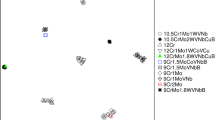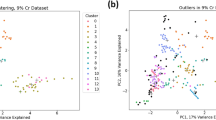Abstract
Data-driven analytical clustering and visualization techniques were applied to the dataset of 9% Cr experimental alloy data generated through the eXtremeMAT project. Techniques and results were compared with the resulting clusters obtained through similar analytical techniques on previous and reduced versions of the dataset. The principal components were generated in order to reduce the dimensionality of the complex dataset and to visualize the underlying trends in the data. Partitioning around medoids was performed on the resulting principal components to determine relevant clusters. Domain knowledge labels were further applied to the principal components to compare the labels with the trends identified through the clustering methods. The clusters can be used to compare the tensile properties of the alloys and to reduce the variation in the dataset.
Access this chapter
Tax calculation will be finalised at checkout
Purchases are for personal use only
Similar content being viewed by others
References
NIMS (1982) Fatigue data sheet series, no. 30. National Institute for Materials Science, Tsukuba-shi
NIMS (1982) Fatigue data sheet series, no. 29. National Institute for Materials Science, Tsukuba-shi
NIMS (1983) Fatigue data sheet series, no. 35. National Institute for Materials Science, Tsukuba-shi
NIMS (1994) Creep data sheet, no. 13B. National Institute for Materials Science, Tsukuba-shi
NIMS (1997a) Creep data sheet, no. 19B. National Institute for Materials Science, Tsukuba-shi
NIMS (1997b) Creep data sheet, no. 44. National Institute for Materials Science, Tsukuba-shi
NIMS (1998) Creep data sheet, no. 10B. National Institute for Materials Science, Tsukuba-shi
NIMS (2002) Fatigue data sheet series, no. 88. National Institute for Materials Science, Tsukuba-shi
NIMS (2005) Creep data sheet, no. 46A. National Institute for Materials Science, Tsukuba-shi
NIMS (2012) Creep data sheet, no. 48A. National Institute for Materials Science, Tsukuba-shi
NIMS (2013a) Creep data sheet, no. 51A. National Institute for Marine Science, Tsukuba-shi
NIMS (2013b) Creep data sheet, no. 52A. National Institute for Materials Science, Tsukuba-shi
NIMS (2014) Creep data sheet, no. 43A. National Institute for Materials Science, Tsukuba-shi
Wenzlick M et al (2020) Data assessment method to support the development of creep-resistant alloys. Integrating Mater Manuf Innovation 9(1):89–102. https://doi.org/10.1007/s40192-020-00167-3
Krishnamurthy N et al (2019) 9Cr steel visualization and predictive modeling. Comput Mater Sci 168:268–279. https://doi.org/10.1016/j.commatsci.2019.03.015
Krishnamurthy N et al. (2018) Data analytics for alloy qualification. National Energy Technology Lab. (NETL), Pittsburgh, PA, and Morgantown, WV
Romanov VN et al (2019) Materials data analytics for 9% Cr family steel. Stat Anal Data Min ASA Data Sci J 12(4):290–301
Verma A et al. (2018) Mapping multivariate influence of alloying elements presentation. in MSLE. Carnegie Mellon University
Verma AK et al (2019) Mapping multivariate influence of alloying elements on creep behavior for design of new martensitic steels. Metall Mater Trans A 50(7):3106–3120. https://doi.org/10.1007/s11661-019-05234-9
Verma AK et al (2020) Predictions of long-term creep life for the family of 9–12 wt% Cr martensitic steels. J Alloy Compd 815:152417. https://doi.org/10.1016/j.jallcom.2019.152417
Verma AK et al (2019) Screening of heritage data for improving toughness of creep-resistant martensitic steels. Mater Sci Eng, A 763:138142. https://doi.org/10.1016/j.msea.2019.138142
Wold S, Esbensen K, Geladi P (1987) Principal component analysis. Chemometr Intell Lab Syst 2(1–3):37–52
Rousseeuw PJ, Kaufman L (1990) Finding groups in data. Wiley Online Library, Hoboken, p 1
Acknowledgements
This work was performed in support of the US Department of Energy’s Fossil Energy Crosscutting Technology Research Program. This work was supported by the NETL Crosscutting Research Program, Briggs White, NETL Technology Manager, and Regis Conrad, DOE-FE HQ Program Manager. The research was executed through the eXtremeMAT National Laboratory Field Work Proposal (NETL: FWP-1022433, LANL: FWP-FE85017FY17, ORNL: FWP-FEAA134, Ames: FWP-AL-17-510091, LLNL: FWP-FEW0234, INL: FWP-B000-17016, PNNL: FWP-71133). Research performed by Leidos Research Support Team staff was conducted under the RSS contract 89243318CFE000003.
Disclaimer
This work was funded by the Department of Energy, National Energy Technology Laboratory, an agency of the United States Government, through a support contract with Leidos Research Support Team (LRST). Neither the United States Government nor any agency thereof, nor any of their employees, nor LRST, nor any of their employees, makes any warranty, expressed or implied, or assumes any legal liability or responsibility for the accuracy, completeness, or usefulness of any information, apparatus, product, or process disclosed, or represents that its use would not infringe privately owned rights. Reference herein to any specific commercial product, process, or service by trade name, trademark, manufacturer, or otherwise, does not necessarily constitute or imply its endorsement, recommendation, or favoring by the United States Government or any agency thereof. The views and opinions of authors expressed herein do not necessarily state or reflect those of the United States Government or any agency thereof.
Author information
Authors and Affiliations
Corresponding author
Editor information
Editors and Affiliations
Rights and permissions
Copyright information
© 2021 The Minerals, Metals & Materials Society
About this paper
Cite this paper
Wenzlick, M., Mamun, O., Devanathan, R., Rose, K., Hawk, J. (2021). Incorporating Historical Data and Past Analyses for Improved Tensile Property Prediction of 9% Cr Steel. In: TMS 2021 150th Annual Meeting & Exhibition Supplemental Proceedings. The Minerals, Metals & Materials Series. Springer, Cham. https://doi.org/10.1007/978-3-030-65261-6_42
Download citation
DOI: https://doi.org/10.1007/978-3-030-65261-6_42
Published:
Publisher Name: Springer, Cham
Print ISBN: 978-3-030-65260-9
Online ISBN: 978-3-030-65261-6
eBook Packages: Chemistry and Materials ScienceChemistry and Material Science (R0)




